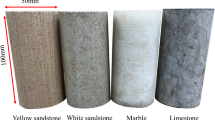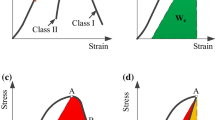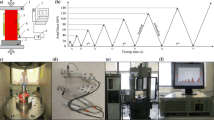Summary
New experiments were conducted to expand the existing information on AE and pulse velocity changes. In this study, a few Hyderabad granites were subjected to uniaxial compressive cyclic loading conditions at room temperature. The laboratory tests were carried out by loading the rock to a constant stress maximum ranging between 40% and 80% of failure stress in the initial cycles, and then by progressively increasing the stress maximum, and also increasing the time gap between the cycles. Compressional wave velocity and amplitude changes were monitored in directions perpendicular to the applied stress, and acoustic emission event count data were recorded continuously until the fatigue failure of the rock.
Rock specimens loaded cyclically to high stress levels, were in general found to fail after 10 to 12 cycles, at stresses corresponding to nearly 75% of the failure stress of intact rock. Deviations from the Kaiser effect were noticed when the stress maximum became comparable to the dilatant strength of the rock. The pulse amplitude and AE event counts were found to be sensitive parameters, to study the influence of cyclic stress, as well as the effect of the time gap between the cycles, on the microcrack development and progressive failure of rock.
Similar content being viewed by others
References
Costin, L. S., Holcomb, D. J. (1981): Time-dependent failure of rock under cyclic loading. Tectonophys. 79, 279–296.
Goodman, R. E. (1963): Subaudible noise during compression of rocks. Geol. Soc. Am. Bull. 74, 487–490.
Gupta, I. N. (1973): Seismic velocities in rock subjected to axial loading upto shear fracture. J. Geophys. Res. 78, 6936–6942.
Hadley, K. (1976): The effect of cyclic stress on dilatancy: Another look. J. Geophys. Res. 81, 2471–2474.
Hardy, H. R. Jr., Zhang, D., Zelanko, J. C. (1989): Recent studies of the Kaiser effect in geologic materials. In: Proc., 4th Conf. on Acoustic Emission/Microseismic activity in geologic structures and materials. Trans. Tech. Publ., Clausthal, 27–55.
Holcomb, D. J. (1981): Memory, relaxation and microfracturing in dilatant rock. J. Geophys. Res. 86, 6235–6248.
Kaiser, J. (1953): Erkenntnisse und Folgerungen aus der Messung von Geräuschen bei Zugbeanspruchung von metallischen Werkstoffen. Arch. Eisenhüttenwesen 24, 43–45.
Kranz, R. L. (1979): Crack growth and development during creep of Barre granite. Int. J. Rock Mech. Min. Sci. 16, 23–35.
Kurita, K., Fujii, N. (1979): Stress memory of crystalline rocks in acoustic emission. Geophys. Res. Letters 6, 9–12.
Kusunose, K., Nishizawa, O. (1986): AE gap prior to local fracture of rock under uniaxial compression. J. Phys. Earth 34, Suppl., 845–856.
Lockner, D. A., Walsh, J. B., Byerlee, J. D. (1977): Changes in seismic velocity and attenuation during deformation of granite. J. Geophys. Res. 82, 5374–5378.
Ramana, Y. V., Rao, M. V. M. S. (1974): Compressional velocities in ultramafic rocks of India at pressure to five kilobars. Geophys. J. Royal Astron. Soc. 37, 207–212.
Rao, M. V. M. S., Ramana, Y. V. (1974): Dilatant behaviour of ultramafic rocks during fracture. Int. J. Rock Mech. Min. Sci. 11, 193–203.
Rao, M. V. M. S., Sun, X., Hardy, H. R. Jr. (1989): An evaluation of the amplitude distribution of AE activity in rock specimens stressed to failure. In: Khair, W. (ed.), Proc., 30th U. S. Rock Mechanics Symposium. Balkema, Rotterdam, 261–268.
Rao, M. V. M. S., Nishizawa, O., Kusunose, K., Satoh, T. (1991): Spatio-temporal evolution of failure process in dilatant rock under triaxial creep. In: Proc., 4th World Meeting on Acoustic Emission, Boston.
Soga, N., Mizutani, H., Spetzler, H., Martin, R. J. (1978): The effect of dilatancy on velocity anisotropy in Westerly granite. J. Geophys. Res. 83, 4451–4458.
Sondergeld, C. H., Estey, L. H. (1981): Acoustic emission study of microfracturing during the cyclic loading of Westerly granite. J. Geophys. Res. 86, 2915–2924.
Spetzler, H. (1978): Seismic velocity changes during fracture and frictional sliding. Pure Appl. Geophys. 116, 732–742.
Tapponnier, P., Brace, W. F. (1976): Development of stress induced microcracks in Westerly granite. Int. J. Rock Mech. Min. Sci. 13, 103–112.
Thill, R. E. (1972): Acoustic methods for monitoring failure in rock. In: Hardy, H. R. Jr., Stefanko, R. (eds.), Proc., 14th U. S. Symposium on Rock Mechanics. ASCE, New York, 649–687.
Yanagidani, T., Ehara, S., Nishizawa, O., Kusunose, K., Terada, M. (1985): Localization of dilatancy in Oshima granite under constant uniaxial stress. J. Geophys. Res. 90, 6840–6858.
Zoback, M. D., Byerlee, J. D. (1975): The effect of cyclic differential stress on dilatancy in Westerly granite under uniaxial and triaxial conditions. J. Geophys. Res. 80, 1526–1530.
Author information
Authors and Affiliations
Rights and permissions
About this article
Cite this article
Rao, M.V.M.S., Ramana, Y.V. A study of progressive failure of rock under cyclic loading by ultrasonic and AE monitoring techniques. Rock Mech Rock Engng 25, 237–251 (1992). https://doi.org/10.1007/BF01041806
Issue Date:
DOI: https://doi.org/10.1007/BF01041806




